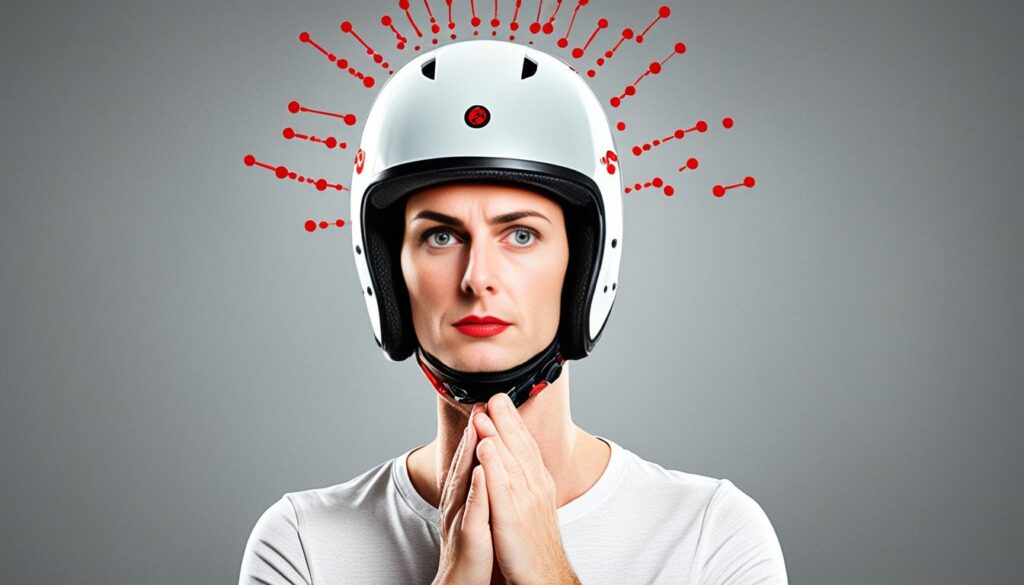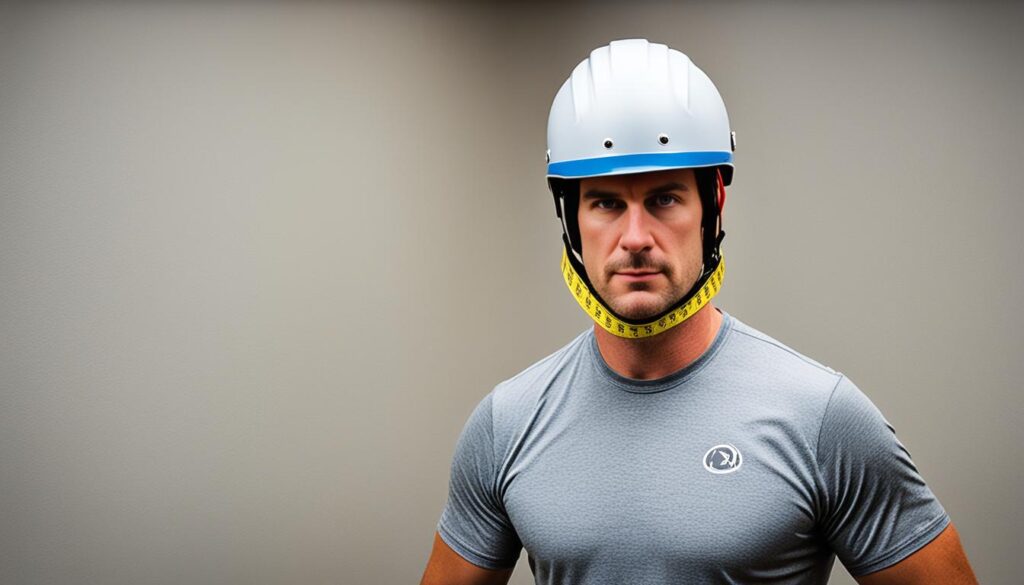
How snug should your motorcycle helmet be? Are you certain that your helmet provides the proper fit? The comfort level of your helmet plays a crucial role in ensuring your safety while riding. In this comprehensive guide, we will delve into the intricacies of motorcycle helmet fitment and provide you with valuable tips for finding the perfect helmet size.
Key Takeaways:
- Finding the ideal balance between snugness and comfort is essential for a properly fitting motorcycle helmet.
- A full-face helmet should fit snugly without causing any pressure points, ensuring a secure and safe ride.
- Pressure points indicate an incorrect helmet shape, which may lead to discomfort during rides.
- Measuring your head’s circumference accurately is crucial for finding the right helmet size.
- Adjusting your helmet for a snug fit without compromising its integrity is important for optimal safety and comfort.
How Tight Should a Full-Face Helmet Fit?
When it comes to the fit of a full-face helmet, it is important to ensure a snug and secure fit without any pressure points. The helmet should sit comfortably on your head and not be able to move around. A properly fitted full-face helmet is crucial for both comfort and safety.
To achieve the right fit, there should be no side-to-side or up-and-down movements when wearing the helmet. The chin guard should not come into contact with your face. Having a helmet that is too tight or too loose can compromise the level of comfort and safety it provides.
Motorcycle industry experts recommend the following guidelines for fitting a full-face helmet:
- Measure your head circumference using a cloth tape measure.
- Refer to the helmet size chart of the specific brand to determine the appropriate size.
- Try on the helmet and adjust the straps to ensure a snug fit.
- The helmet should feel secure, but not overly tight.
- Make sure there are no pressure points on your forehead or the sides of your head.
Remember, a properly fitted full-face helmet provides optimal protection and comfort while riding, reducing the risk of injury. It is always advisable to try on the helmet before making a purchase to ensure the best possible fit.
What to Do If You Feel Pressure Points in a Helmet
When trying on a helmet, it is crucial to pay attention to any pressure points on your forehead or the sides of your head. These pressure points can be indicators that the helmet is either too round or too oval for your head shape, leading to discomfort and potential issues in the long run. Addressing these pressure points is essential to ensure a comfortable and enjoyable riding experience.
Identifying Helmet Pressure Points
During the fitting process, take note of any areas where the helmet feels tight or creates excessive pressure on your head. These pressure points can cause discomfort, headaches, and even distract you from focusing on the road. Common areas where pressure points may occur include the forehead, temples, and sides of the head.
Causes of Helmet Pressure Points
Helmet pressure points often arise from a mismatch between the shape of the helmet and the shape of your head. A helmet that is too round for your head shape can create excessive pressure on the sides, while a helmet that is too oval can cause discomfort on the forehead.
In some cases, pressure points may also be a result of incorrect sizing or improper adjustment of the helmet’s padding and straps. It is important to ensure that the helmet is properly adjusted and sits snugly on your head without exerting excessive force.
Addressing Discomfort from Helmet Fit
If you experience pressure points or discomfort from your helmet fit, there are a few steps you can take to alleviate the issue:
- Try Different Sizes or Helmet Shapes: If the pressure points persist, consider trying helmets with different sizes or shapes to find one that better suits your head shape.
- Adjust Internal Padding: Some helmets allow for the adjustment of internal padding to achieve a more customized fit. Experiment with different thicknesses or positions of the padding to alleviate pressure points.
- Replace or Modify Padding: In some cases, replacing or modifying the padding of your helmet can help alleviate pressure points. Consult with a helmet specialist or manufacturer for guidance on this option.
- Consult a Professional Fitter: If you are unable to find a solution on your own, consider seeking the assistance of a professional helmet fitter. They can assess your head shape and recommend helmets that are better suited to your needs.
Remember, a properly fitting helmet should provide adequate protection without causing discomfort or pressure points. It is worth investing the time and effort to find a helmet that fits you well, ensuring both your safety and comfort on every ride.

Measuring and Sizing Your Helmet
Properly measuring your head is crucial for finding the right helmet size. Follow these steps to ensure an accurate measurement:
- Use a cloth tape measure to measure the circumference of your head above the eyebrows.
- Then, measure the thickest point at the rear of your head.
- Cross-reference this measurement with a helmet size chart to determine the correct size.
Keep in mind that different helmet brands may have slightly different sizing, so it’s always best to try on a helmet before purchasing. Remember, finding the right fit is essential for your safety and comfort on the road.
| Helmet Size | Head Circumference (in inches) |
|---|---|
| XS | 20 7/8 – 21 1/4″ |
| S | 21 5/8 – 22″ |
| M | 22 3/8 – 22 3/4″ |
| L | 23 1/8 – 23 1/2″ |
| XL | 24 – 24 3/8″ |
| XXL | 24 3/4 – 25 1/4″ |
Remember, when measuring your head, accuracy is key. A properly fitted helmet ensures maximum protection, so take the time to find the right size.

Adjusting Your Helmet
Ensuring a proper helmet fit is essential for both comfort and safety during your motorcycle rides. Some helmet manufacturers offer features that allow you to adjust the interior shape and fit of the helmet. One such feature is replaceable cheek pads and liners, which can be customized to provide a more personalized fit.
It’s important to note that while adjustments can enhance the fit, any alterations to the inside of the helmet may compromise its integrity and void the warranty. Therefore, it’s crucial to follow the manufacturer’s guidelines for adjusting your helmet and avoid making modifications that are not recommended.
When adjusting your helmet, pay attention to two critical areas: the crown and the cheeks. The crown area refers to the top of your head, while the cheeks encompass the sides of your face. The fit around the crown should feel snug, providing a secure and stable feel without causing discomfort or pressure points.
The cheek fit is equally important. It should be tight enough to prevent the helmet from moving around or shifting during your ride, but not so tight that it causes discomfort or restricts your ability to open and close your mouth comfortably. The cheek pads should gently press against your cheeks without excessive pressure.
Remember, a well-adjusted helmet should offer a balance between comfort and stability. Take the time to find the right adjustment settings for your specific helmet model and ensure a secure fit that doesn’t compromise your safety on the road.
Tips for Adjusting Your Helmet
| Tip | Explanation |
|---|---|
| Follow the manufacturer’s instructions | Always refer to the helmet manual or manufacturer’s website for specific adjustment recommendations. |
| Replace cheek pads and liners if necessary | If your helmet allows it, consider replacing cheek pads and liners to achieve a better fit. |
| Ensure a snug fit around the crown | The top of your head should feel secure without causing discomfort or pressure points. |
| Check the tightness of the cheek fit | The cheek pads should provide a secure fit without causing excessive pressure on your cheeks. |
| Test the helmet for stability | Shake your head gently to ensure the helmet stays in place and doesn’t shift during your ride. |
Understanding Helmet Styles
When it comes to motorcycle helmets, there is a wide range of styles available, each catering to different types of riding preferences and safety requirements. Understanding the various helmet styles can help you make an informed decision and choose the right helmet for your needs.
Full-Face Helmet
The full-face helmet offers the most comprehensive protection and is designed to cover your entire head, including your face. It provides excellent aerodynamics and minimizes wind noise, making it ideal for high-speed riding and long-distance journeys. The full-face helmet offers a chin bar and a visor, ensuring maximum safety and protection for your face and eyes.
Modular Helmet
A modular helmet combines features of both full-face and open-face helmets. It provides the flexibility to switch between a full-face mode and an open-face mode by flipping up the chin bar. This style is popular among riders who want the option of an open-face helmet for better ventilation or communication convenience, without compromising the protection of a full-face helmet.
Dual-Sport Helmet
Dual-sport helmets are specifically designed for adventure riding and offer versatile functionality. These helmets provide a blend of features from both street and off-road helmets. They come with a peak visor to provide shade from the sun, a larger visor opening for goggles, and enhanced airflow for increased ventilation during off-road excursions.
Off-Road Helmet
Off-road helmets are built for riders who typically engage in off-road activities like motocross or enduro. These helmets prioritize airflow, ventilation, and durability. They feature a large visor opening to accommodate goggles, a distinct chin bar design for easy breathing, and aggressive styling to withstand the rigorous demands of off-road riding.
Hi-Viz Helmet
Hi-viz helmets are designed with bright, fluorescent colors to enhance visibility on the road. These helmets increase your visibility to other motorists, especially in low-light or adverse weather conditions. Hi-viz helmets are popular among riders who prioritize safety and want to stand out on the road.
Half Helmet
A half helmet, also known as a “brain bucket,” covers only the top of your head, leaving your face and ears exposed. While it offers limited protection compared to other helmet styles, it provides a sense of freedom and lightweight comfort. Half helmets are often favored by cruiser riders and those who value the open-air riding experience.
Open-Face Helmet
Open-face helmets provide coverage to the top, back, and sides of your head, leaving your face exposed. They offer more protection than half helmets but less than full-face helmets. Open-face helmets are popular among urban riders and scooter enthusiasts who prioritize ventilation, visibility, and ease of communication.
Choosing the right helmet style depends on your riding preferences, safety requirements, and the kind of riding you plan to do. Whether you’re touring on highways, hitting the dirt trails, or commuting to work, there’s a helmet style designed to meet your specific needs.
| Helmet Style | Protection Level | Main Features |
|---|---|---|
| Full-Face Helmet | High | Aerodynamics, comprehensive coverage, chin bar, visor |
| Modular Helmet | High | Flexibility, full-face and open-face options, chin bar |
| Dual-Sport Helmet | Medium | Adventure riding, peak visor, increased airflow |
| Off-Road Helmet | Medium | Motocross, enduro, enhanced ventilation, large visor opening |
| Hi-Viz Helmet | Medium | Bright colors, increased visibility, safety |
| Half Helmet | Low | Lightweight, freedom, partial head coverage |
| Open-Face Helmet | Low | Ventilation, visibility, communication |
Helmet Safety Standards
Helmet safety standards play a crucial role in ensuring the protection and safety of motorcycle riders. These standards establish specific requirements that helmets must meet to provide adequate head protection in the event of a crash.
In the United States, one of the most recognized and widely adopted safety standards for motorcycle helmets is the DOT (Department of Transportation) certification. DOT-compliant helmets undergo rigorous testing to ensure they meet the required safety standards.
DOT-certified helmets can be identified by the presence of a label on the back of the helmet, usually affixed with a sturdy adhesive. This label proves that the helmet has passed the necessary tests and meets the safety requirements set by the DOT.
When shopping for a motorcycle helmet, it is crucial to choose one that is DOT-compliant. Novelty helmets or helmets without proper certification may not provide the same level of protection as DOT-approved helmets. These uncertified helmets may lack the necessary impact resistance or structural integrity, increasing the risk of severe head injuries in the event of an accident.
It is important to note that the DOT certification is specific to the United States, and different regions may have their own safety standards. If you reside outside of the US, familiarize yourself with the helmet safety standards and certifications applicable in your country or region.
Identifying Genuine DOT Labels
While purchasing a DOT-compliant helmet is essential, it is equally important to be aware of counterfeit or fake DOT labels that may be present on non-certified helmets. Some unscrupulous manufacturers may attempt to deceive consumers by affixing counterfeit labels on their helmets.
When examining a helmet for a DOT label, there are a few key indicators that can help you identify genuine certification:
- Look for the letters “DOT” prominently displayed on the label.
- The label should also include the manufacturer’s name or logo, a representation of the helmet model, and the helmet’s production or Serial number.
- The font size and clarity of the lettering should be consistent and easily readable.
- A genuine DOT label should be securely affixed to the helmet, exhibiting no signs of tampering or removal attempts.
If you suspect that a helmet’s DOT label is counterfeit or fake, it is best to avoid purchasing or using the helmet. Prioritize your safety by choosing helmets from reputable brands and authorized distributors to ensure you receive a genuine DOT-compliant product.
Remember, investing in a DOT-certified helmet not only ensures compliance with safety standards but also provides you with peace of mind knowing that you have made a responsible choice in protecting your head.
Conclusion
Finding the optimal fit for your motorcycle helmet is crucial for your safety and comfort while riding. The helmet should be snug without causing discomfort or pressure points. Proper measurement, sizing, and adjustment are key factors in achieving the ideal fit. Additionally, selecting a helmet style that suits your riding needs is important. Always prioritize safety by choosing DOT-compliant helmets that meet the necessary safety standards. By following these guidelines, you can ensure that your helmet fits perfectly and provides maximum protection on your motorcycle journeys.
Source Links
- https://agvsport.com/blog/helmets/how-tight-should-full-face-helmet-fit.html
- https://www.nhtsa.gov/motorcycle-safety/choose-right-motorcycle-helmet
- https://bellracing.com/helmet-sizing

Meet James Smith, affectionately known by friends as ‘Biker Smith’, your go-to expert at ‘Best HD Helmet Camera’. At 35, living in the USA, James embodies the spirit of adventure. His life is a thrilling ride, powered by his Harley Davidson Softail and BMW S 1000 RR, with his girlfriend as his favorite travel companion. A software developer by profession, James’s heart beats for the open road, making him a full-time traveler at heart. His passion for biking and technology merges seamlessly on this platform. Recognizing a gap in discussions around helmet cameras, he founded this blog to educate and inspire fellow enthusiasts. His mission? To elevate your riding experience with the best HD helmet camera insights, backed by firsthand experiences, rigorous testing, and a genuine love for the ride. Trust James to guide you through the world of helmet cameras, where quality, innovation, and safety ride together.